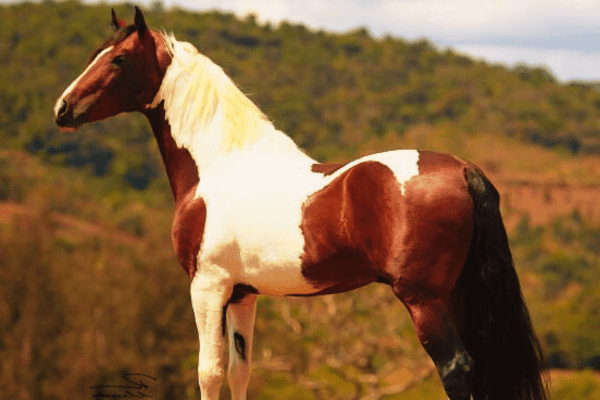Brazil is home to an exquisite horse breed called the Pampa Horse, distinguished by its striking pinto coat. Derived from breeds like Mangalarga Marchador and Campolina, this majestic beast not only stands out with its captivating appearance but also stands out with strength, agility and graceful gaits – an irresistibly beautiful combination that illuminates any landscape it traverses.
The Pampa Horse stands out not just by its aesthetic appeal but for its versatility in riding, sport and work. Originating in Brazil’s wide-ranging equestrian traditions, its birth is testament to this region’s rich equine legacy and registration regulations ensure it maintains its unique visual identity while remaining an iconic representation of Brazil’s dynamic and diverse equine landscape.
With each stride and gentle trot, the Pampa Horse tells a captivating tale of Brazil’s equine glory; combining aesthetic beauty with utilitarian robustness into an iconic model that holds special place in hearts of horse enthusiasts around the globe.
History:
Travel back through time to witness the Pampa Horse’s rich and complex tale, from its exploration through conflict to becoming an iconic symbol for Brazil itself. Renowned for their distinctive spotted coat, they soon became not only objects of admiration among equestrian enthusiasts but also an integral symbol for its long and turbulent history.
Beginning its story surrounded in mystery, its exact date of arrival remains undocumented in Brazilian history. Thought to have originated by Spanish settlers bringing robust Andalusian and Jaca Navarra horses into South America’s varied terrains. Their descendants later evolved into Criollo and Campeiro breeds, leaving their mark upon this continent’s rich equestrian legacy.
Pampa horses with their distinctive spotted coat may owe their design to Portuguese settlers or horses imported during the 1629 Dutch invasion, each theory offering up an explanation for where this beautiful pattern first emerged in Brazilian equine history.
The Pampa horse tells its own unique tale in both name and Tobiano coat: Brigadier Rafael Tobias de Aguiar was both a revolutionary and breeder during Brazil’s mid-19th century, breeding mesmerizing pinto horses while leading the Liberal Revolution alongside Father Diogo Antonio Feijo against conservative forces during Dom Pedro II’s rule. Together they united their voices against Conservative supporters while raising voices against Conservative forces which sought power.
Tobias embodies the fierce determination of the Pampa Horse. Following defeat against imperial forces in Sorocaba province, Tobias fled southward with his army and horses for Rio Grande do Sul to seek alliance with rebels of Ragamuffin War. However, only six months post his escape he was apprehended in Palmeira das Missoes and imprisoned at Laje Fortress, in Rio de Janeiro.
Pampa Horse history is an intricate tapestry, telling tales of migrations, wars, revolutions and breed excellence through generations. Not only is the Pampa Horse an eye-catching breed with exquisite visual appeal; but its journey embodies stories of struggle, perseverance and unyielding spirit that forever gallops through Brazil’s annals.
Physical Properties: Forbidden Coats and Robust Frames
Pampa Horses, famous for their vibrant pinto patterns, instantly captivate. Beyond their captivating visual allure lies a muscular body and sturdy legs which speak volumes about strength and perseverance.
Size and Spirit Flexibility:
Pampa horses stand 14.2- 16 hands at their shoulders, offering both size and adaptability in equal measures to easily navigate tranquil trails or competitive arenas with equal ease.
Striking Coats and Robust Frames:
A mesmerizing canvas of colors, the Pampa Horse, renowned for its vibrant pinto patterns, instantly captivates. Beyond its visual allure, its muscular physique and sturdy legs whisper tales of inherent strength and enduring stamina.
At first glance, the Pampa Horse stands out as not just an image of equestrian beauty but also as an embodiment of versatile strength and collective uniqueness – always leaving an impactful mark upon those who witness its colorful spectacle.

Temperament:
Pampa Horses are beloved favorites among riders of all experience levels due to their calm, friendly, and sociable disposition. Generations of selective breeding has focused on creating horses with this temperament who work harmoniously alongside humans; not compromising vitality with doliceity – making these gentle giants beloved companions. Although calm yet energetic horses, Pampas still exhibit lively energy that makes them favorites among riders of all experience levels.
Versatility:
Pampa Horses have long been recognized for their versatility. From cattle herding on sprawling Brazilian ranches to dressage arenas, Pampas have proven their worth in various equestrian disciplines. Furthermore, their sturdy build and resilient nature makes them great candidates for endurance riding – an equestrian discipline which tests both horse and rider for strength and stamina.
Preservation and Recognition:
Pampa horses have already established themselves within Brazil’s equestrian community, but worldwide recognition remains elusive. Breeding programs and associations across Brazil are dedicated to protecting and promoting this beautiful yet capable horse so future generations may continue to benefit from its unparalleled versatility and friendly personality.

